Improving the UX in the flower sector — UX Research
 Everybody loves when spring arrives. The strong and inspiring blue of the sky, the colors in the cities fulfilling of flowers, and the good smelling of been in one of the most beautiful seasons of the year. So, happy because we are in the beautiful springtime, I’d like to focus more on the thing: The flower, and it is on that basis that we focus our project.
Everybody loves when spring arrives. The strong and inspiring blue of the sky, the colors in the cities fulfilling of flowers, and the good smelling of been in one of the most beautiful seasons of the year. So, happy because we are in the beautiful springtime, I’d like to focus more on the thing: The flower, and it is on that basis that we focus our project.
Due to the current situation of the pandemic and everything that has been affecting it, specifically in commerce, the world as a whole has had to rethink what it had been doing, since many businesses, having no presence on the web or not being prepared for digital demand has undergone irreparable changes, as has been the case in the flower sector. So, we have the challenge to improve the UX in the floral industry, reinventing the purchase of flowers and plants, and taking into account the circular design.
Being the flower such a physical product, which everybody must immerse in it (its smell, color, beauty) selling it online makes the process completely different from doing it live. This means that concerning the digitization of the flower sector, it must be done with special care, seeking innovative ideas that can bring the user closer to that real experience.
But this isn’t an easy task, because everyone wants to feel it. Everyone wants to smell the flower, touch it, and be caught up in the story that a particular flower can convey.
All that creates uncertainties, but it is the fun part of creation… So, how to do it? How to transmit the smell of a flower? How to make it feel like they’re buying a flower? Because this is the most important thing for users.
And now we started. We carried out this project using Design Thinking, which is a human-centered methodology that uses tools in the field of design to solve problems, so I would help us to know the needs of users, understand their motivations, pain points … To make a product that gives them a good experience.
Part I: Empathize
It is here where we seek to understand the problem from the perspective of the user and the organization. In the UX Research phase, we find different research techniques, which have to be chosen depending on the needs of the project. In this case, (although we would have liked to carry out the ethnography, we could not apply due to confinement) we decided to carry out an in-depth interview and surveys.
Empathy is at the heart of design. Without the understanding of what others see, feel, and experience, design is a pointless task. — Tim brown
Once this was understood, we got to work. The first thing we did was define the Research Questions, which focus on 3 aspects: Users, Competition, and Product. Each team member wrote their questions around these three aspects, and then we dumped all the information into the Miro, in this way we had a broader view of all questions.
After this, we had to choose (dotmocracy) the questions that are closer to our project and are more relevant. These would be the ones that would later help us focus our interviews and surveys, as well as the benchmark.
Once the voting is done, we carry out the Benchmark, to measure similar companies and identify internal opportunities for improvement. For this, we chose 8 florists and defined the criteria to evaluate it, taking into consideration the Research Questions that we had previously done. We also highlight the values of the brands, to know what they were doing well.
Then, the previous questions about users helped us to define the approach that we would give to our surveys and interview, we focused on: What do we feel when we buy flowers? Why do we buy flowers? And what are the reasons for our decision?.
Survey and Interview
In this way, we carry out the survey, which we carry out using Google Forms and send it to more than 100 people. As for the interview, using the same approach of the victorious questions of the Research Questions, we made our script.
The deep interview helps to know the users better and obtain valuable information, such as their motivations and frustrations that will help us solve our problem later on. We selected 3 people who met the characteristics of our potential users.
Once the results of the interview and survey were obtained, the points were clear, some of which were: Most of those who buy are women and buy mostly on special occasions, and prefer to buy the flowers or plants live — smell them, see them, feel them- and almost nobody knows how to take care of their plants … They die! So they would appreciate being able to do workshops or courses on their care.
Personas
All this information and these data allowed us to define our User Persona. Each one made a Persona, establishing the frustrations (pain points) and motivations that we had obtained from the interviews and surveys. All this would then allow us to focus our solutions on the needs of our users.
Apart from the User Persona, we also carry out an Empathy Map, to have a broader vision of what our users think, see, hear, and feel. With the last two, we were able to reach the most anticipated part of the empathy stage: User Journey, where we included the stages of our users during a certain circumstance, the activities they carried out, points of contact, their emotions during each stage and the pain points.
With this, we would conclude the first step of Design Thinking.
Part II: Define
With all the information collected, we started the stage of defining the insights — the needs of the users — in order to deeply understand the essence of the problem.
After these insights, we defined the HMW, (How might we?) and as many ideas always appear, we took on the task of doing a group vote (dotmocracy), so we did the well-known dotmocracy to synthesize the most relevant ideas.
In this way, the phase of UX Research would come to an end.
Step 3: Ideate
The funniest part of the process: Ideation! Hand in hand with our header teacher Pere Feliu, we carried out a few techniques to bring out the most innovative ideas — and some very crazy ones — that will direct us to find a solution to our problem determined in the previous stage.
Well, this step seeks to generate ideas and concepts. We started with time trials warm-up techniques. We had a lot of ideas, but we couldn’t keep all of them! After capturing all the ideas in Miro, we used the gomets to vote the best ideas, and then in a 2x2 Matrix, we categorized the ideas into impossible-possible, traditional-innovative.
The goal was to get impossible but innovative ideas to the possible side, to create a truly disruptive product. With all this, things were starting to get a little clearer: The best idea always stands out from the rest.
Value proposition
With all this posed, we were able to decide what our best idea would be and be able to define our value proposition, managing to bring our all the previous concepts to the real world: We would create an innovative App that, using the latest technology would offer all the information, care, and detection of symptoms and possible plant pests.
The App would allow identifying diseases by scanning the plants, diagnosing them, and giving information about home remedies. Besides, since the care of the plants is essential to prevent them from getting sick, using Augmented Reality, the user could scan the spaces of the house in search of the place with the specific amount of light for each type of plant.
With all this, we would avoid the feeling of frustration of the users when their plants get sick and we make them feel fulfilled and satisfied by having healthy plants.
Storyboard and Moodboard
Before starting with the prototyping stage, we first had to get everything ready. So we started with a storyboard: A story about Lucía, a girl who loved plants. One morning, after breakfast, she went to water her plants and realized that her plant was dry and had little bugs that she didn’t know what they were!
She was very sad, so searching on the internet she came across an ad of this new App, and when she downloads it, she realizes that it allows her to diagnose it, to do a light test of the location of the plant, know about its care and be able to buy a remedy! All this would allow her to revive her plant and be happy.
After the storyboard, we create a moodboard, which is an inspiration map with references and styles that could help us guide the look and feel of our project.
It is incredible to see how patterns are seen step by step, and the path we have to follow becomes clearer. Without a doubt, everything we have done has borne fruit. The next steps of the methodology will be explained below in the following article.
Before finishing, I want to thank my team Estefania, Enric, and Stephanie and my teachers Pere Feliu and Nuria Gómez, that together we carry out a great job.
